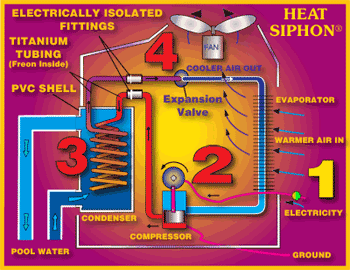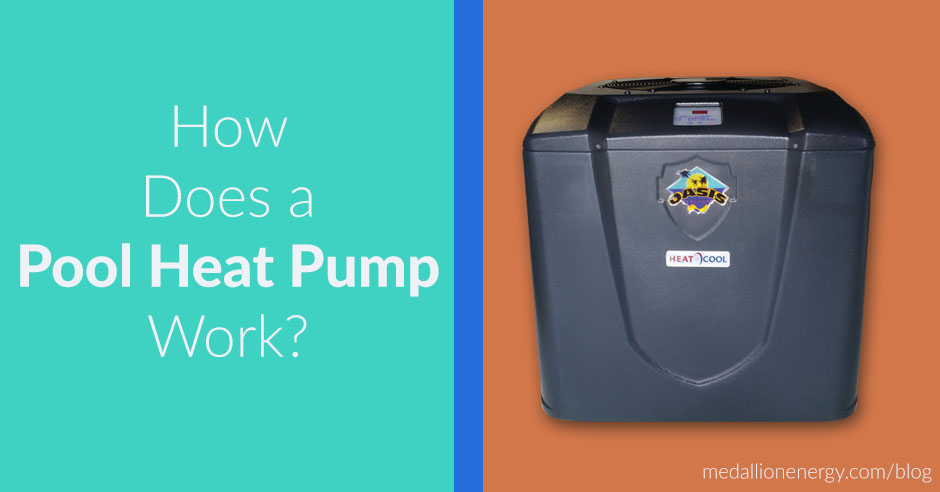Heat pump pool heaters work by harvesting natural heat from the warm air surrounding them. To do this, they use electricity to power a fan with pulls the ambient air into the unit.
The combination of natural heat generation and low energy use paves the way for energy-efficient performance — a staple of pool heat pumps.
But if you’re reading this post, then chances are you want a more in-depth explanation of how a pool heat pump works. You want to to know each step, the details of the process, and how it all results in a warmer and more comfortable swim when you hop in the pool.
Well, you’re reading the right article. Keep reading to learn the step-by-step process a pool heat pump uses for warming up your pool
How Pool Heat Pumps Work
How pool heat pumps work (the short version)



Here’s how a swimming pool heat pump works:
- Pool heat pump receives water from filter pump
- Fan pulls in warm ambient air
- Evaporator coil extracts heat from air
- Extracted heat warms the coil’s cold refrigerant into a warm vapor
- Compressor pressurizes warm vapor into a hot gas
- Hot gas travels through inner tubes of the heat exchanger
- Pool water flows through heat exchanger and warms up
- Hot gas cools down into a liquid as it exits the heat exchanger
- Cooled liquid refrigerant travels through an expansion valve, cooling down more
- Process restarts
Now that you have a basic idea, let’s dive into the details of each step.
How a Pool Heat Pump Works (Step by step)



Filter pump sends water to pool heat pump
Since a pool heat pump needs a steady source of water to operate, your filter pump is a key player in the heating process.
When you filter pump sends water to your heater, the heating process kicks off. As the cold water begins flowing through the heat pump, it gradually makes its way to the heat exchanger.
This is where actual heating takes places, but we’ll get to that soon enough.
For now, let’s focus on the next step: how your pool heat pump gathers heat from the air surrounding it
Fan pulls in warm ambient air
As the water starts flowing, the pool heat pump begins spinning its fan (located at the top of the unit).
The fan creates airflow that pulls in the surrounding air. As the air flows through, it passes over a part called the evaporator coil.
Evaporator coil extracts heat from air
The warm, incoming air interacts with the cool liquid (refrigerant) inside of the evaporator coil. This happens gradually, which results in the cool liquid becoming warmer and warmer.
Once enough air passes over the evaporator coil, the next step of the heating process begins.
Extracted heat warms the coil’s cold refrigerant into a warm vapor
After enough air passes through, the cool liquid in the evaporator coil heats up into a warm vapor.
The warm vapor is key to this step. Without it, there would be no heating process. In order for the process to move past this point, the refrigerant can only be in a vapor or gas form.
But thanks to the fan pulling in all that air and warming up the liquid into a vapor, this isn’t a problem. So as the vapor begins traveling out of the coil, the next step begins.
Compressor pressurizes warm vapor into a hot gas
Vapor from the coils makes its way to next part, the compressor.
The compressor is a major player in the heating process. It’s the part that turns the warm vapor into a gas hot enough to use as a heat source.
To do that, it pressurizes the warm vapor. As the vapor’s pressure increases, so does its temperature. And that’s what turns it into a hot gas.
From here, the hot gas gets pushed out of the compressor and into the heat exchanger.
Hot gas travels through the titanium heat exchanger
In order to understand the rest of the process, it’s important to understand what a heat exchanger is and how it works.
The simplest way to understand a heat exchanger is to break it down into two major parts: the inner tube and out tube.
The outer tubing, usually made of PVC, is where the water travels through. But inside of that tubing is a much smaller, separate titanium tube. The inner titanium tube is where the hot gas flows through.
So basically it’s a tube with a tube.
As hot gas flows through the inner tube, it warms up and emits heat.
Pool water flows through heat exchanger and heats up
As water flows through the outer tube of the heat exchanger, it also flows past the heated inner titanium tube. This “exchange” is where the heating takes places.
Heat stored in the titanium tubing diffuses into the water that flows by. This does two things:
- It warms up the water
- Cools down the hot gas
At this point, the warmed up water leaves the heat pump and exits into your pool. But the heating process isn’t over yet.
Hot gas cools down into a cool liquid as it exits the heat exchanger
As the hot gas inside of the heat exchanger cools down more and more from the cold water, it eventually becomes a cold liquid again.
So basically, the refrigerant gets recycled back into its original form (almost). From there, it exits the heat exchanger as a cold liquid.
Cooled liquid travels through an expansion valve, cooling down more
After exiting the heat exchanger, the cool liquid passes through a part called the expansion valve.
The purpose of this part is to cool off the liquid even more. This makes it cold enough to enter back into the evaporator coil as it started. And at this point, everything starts over.
Heating process restarts
With newly supplied refrigerant, the heating process restarts. The heater continues going through all of the previous steps, repeating the cycle until the target pool temperature is reached.
And that is how a pool heat pump works.
How does a pool heat pump work in winter?
Since a pool heat pump needs warm air to operate, you might be wondering how they work during the winter time.
A valid question. And the answer, well, it may surprise you.
As long as temperatures are still above 50 degrees or so, they work the exact same way. So even if all the leaves have fallen off the trees and the sun is nowhere to be found, you can still warm up the pool.
And while a pool heat pump certainly performs better during warmer weather, it can still do its job as long as the air it’s pulling in is warmer than the cold refrigerant.
For most heaters, this limit is about 50 degrees. But for pool heat pumps like the Oasis Platinum Ultra Quiet, you can heat your pool all the way down to the mid 30s.
Pool Heat Pumps vs Gas



Ah, the pool heating battle of the century.
In one corner, speed. In the other, efficiency.
Although this topic is worthy of a post within itself, we’ll sum it up to this:
Pool heat pumps offer energy efficient heating at a good speed but are limited by freezing temperatures.
Gas pool heaters offer the fastest heating but rely on actual gas, and are, therefore, most expensive.
Related: How Gas Pool Heaters Work
How much does it cost to run a heat pump for a pool
The cost of running a pool heat pump is on the lower end of the pool heating cost spectrum.
Running your pool heat pump each month costs anywhere from $50-$150. Compare this to the average cost of gas at $200-$600 a month and savings become clear.
Of course, how much it costs to heat your pool varies based on a few factors:
- The size of your pool
- The size of your pool heat pump
- Related: How To Size a Pool Heat Pump
- Solar cover use
- Location
Closing thoughts
Now that you know how a pool heat pump works, next is deciding if they’re the right fit for heating your pool. For most, a pool heat pump is a great solution that offers affordable heating in a wide range of climates and weather conditions. Which makes it an excellent tool for extending your pool season, and fitting more swimming time into your schedule.
If you liked this post, you might also like:
- 7 Ways To Extend Your Pool Season By Up To 6 Months
- 9 Ways Owning a Pool Heat Pump Improves Your Health & Your Life
- 7 Ways Heat Pump Swimming pool Heaters Simplify Pool Heating


